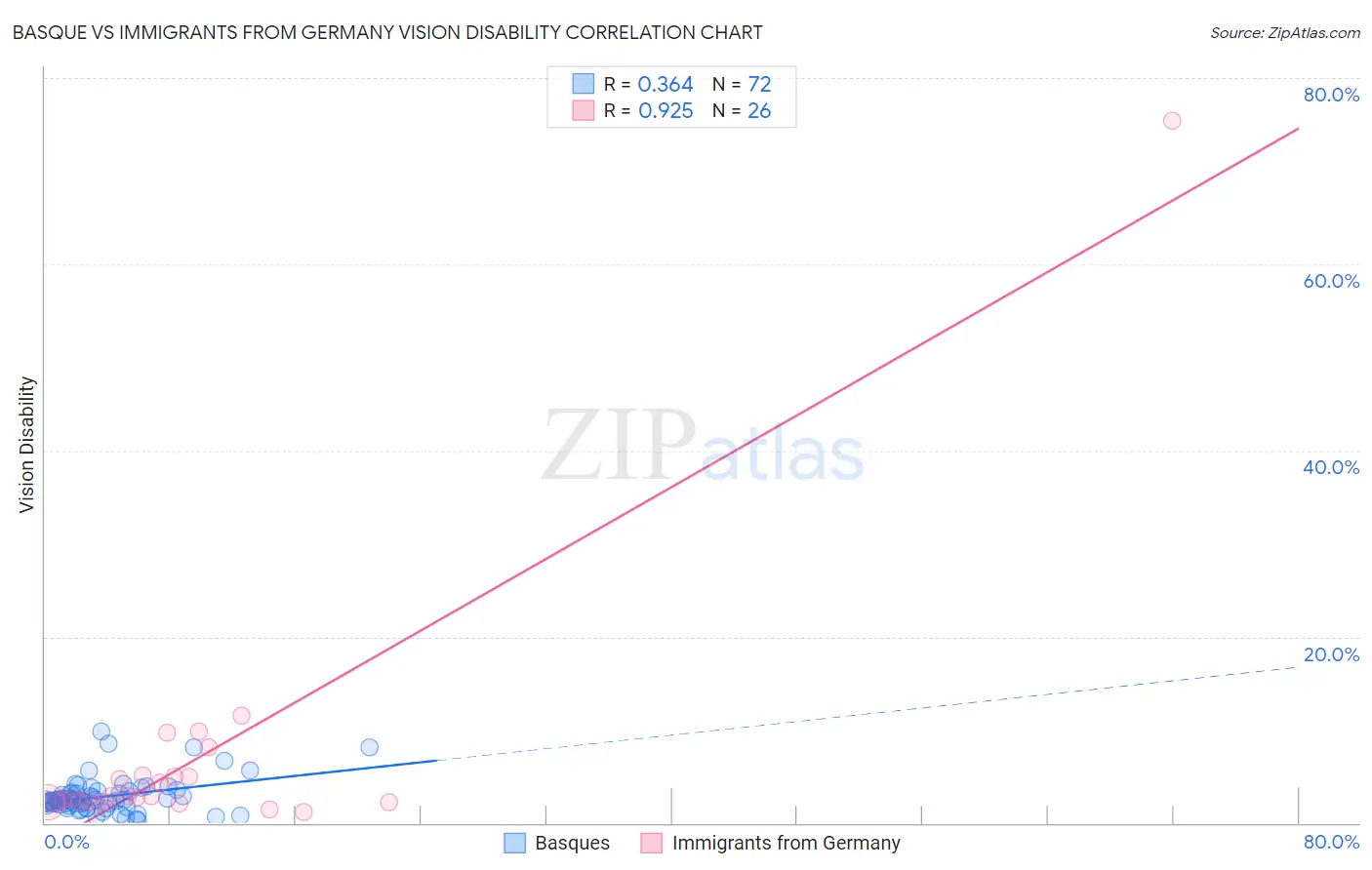Basque vs Immigrants from Germany Vision Disability
COMPARE
Basque
Immigrants from Germany
Vision Disability
Vision Disability Comparison
Basques
Immigrants from Germany
2.3%
VISION DISABILITY
3.5/ 100
METRIC RATING
223rd/ 347
METRIC RANK
2.3%
VISION DISABILITY
3.0/ 100
METRIC RATING
226th/ 347
METRIC RANK
Basque vs Immigrants from Germany Vision Disability Correlation Chart
The statistical analysis conducted on geographies consisting of 165,747,167 people shows a mild positive correlation between the proportion of Basques and percentage of population with vision disability in the United States with a correlation coefficient (R) of 0.364 and weighted average of 2.3%. Similarly, the statistical analysis conducted on geographies consisting of 463,372,189 people shows a near-perfect positive correlation between the proportion of Immigrants from Germany and percentage of population with vision disability in the United States with a correlation coefficient (R) of 0.925 and weighted average of 2.3%, a difference of 0.26%.

Vision Disability Correlation Summary
| Measurement | Basque | Immigrants from Germany |
| Minimum | 0.32% | 1.2% |
| Maximum | 9.8% | 75.4% |
| Range | 9.5% | 74.2% |
| Mean | 2.8% | 6.8% |
| Median | 2.4% | 2.8% |
| Interquartile 25% (IQ1) | 2.0% | 2.2% |
| Interquartile 75% (IQ3) | 3.2% | 5.0% |
| Interquartile Range (IQR) | 1.3% | 2.8% |
| Standard Deviation (Sample) | 1.8% | 14.3% |
| Standard Deviation (Population) | 1.8% | 14.0% |
Demographics Similar to Basques and Immigrants from Germany by Vision Disability
In terms of vision disability, the demographic groups most similar to Basques are Irish (2.3%, a difference of 0.020%), Immigrants from Western Africa (2.3%, a difference of 0.040%), Immigrants from Senegal (2.3%, a difference of 0.14%), French Canadian (2.3%, a difference of 0.16%), and Guamanian/Chamorro (2.3%, a difference of 0.18%). Similarly, the demographic groups most similar to Immigrants from Germany are Hawaiian (2.3%, a difference of 0.050%), Immigrants from Western Africa (2.3%, a difference of 0.22%), Irish (2.3%, a difference of 0.23%), Hmong (2.3%, a difference of 0.29%), and Welsh (2.3%, a difference of 0.37%).
| Demographics | Rating | Rank | Vision Disability |
| Trinidadians and Tobagonians | 8.2 /100 | #214 | Tragic 2.2% |
| Nigerians | 7.2 /100 | #215 | Tragic 2.3% |
| Immigrants | Trinidad and Tobago | 6.1 /100 | #216 | Tragic 2.3% |
| Barbadians | 5.1 /100 | #217 | Tragic 2.3% |
| Portuguese | 4.9 /100 | #218 | Tragic 2.3% |
| Ecuadorians | 4.6 /100 | #219 | Tragic 2.3% |
| Guamanians/Chamorros | 3.9 /100 | #220 | Tragic 2.3% |
| French Canadians | 3.9 /100 | #221 | Tragic 2.3% |
| Immigrants | Senegal | 3.8 /100 | #222 | Tragic 2.3% |
| Basques | 3.5 /100 | #223 | Tragic 2.3% |
| Irish | 3.4 /100 | #224 | Tragic 2.3% |
| Immigrants | Western Africa | 3.4 /100 | #225 | Tragic 2.3% |
| Immigrants | Germany | 3.0 /100 | #226 | Tragic 2.3% |
| Hawaiians | 2.9 /100 | #227 | Tragic 2.3% |
| Hmong | 2.5 /100 | #228 | Tragic 2.3% |
| Welsh | 2.3 /100 | #229 | Tragic 2.3% |
| Nicaraguans | 2.2 /100 | #230 | Tragic 2.3% |
| Immigrants | Ecuador | 2.0 /100 | #231 | Tragic 2.3% |
| German Russians | 1.8 /100 | #232 | Tragic 2.3% |
| Central Americans | 1.8 /100 | #233 | Tragic 2.3% |
| Scottish | 1.6 /100 | #234 | Tragic 2.3% |